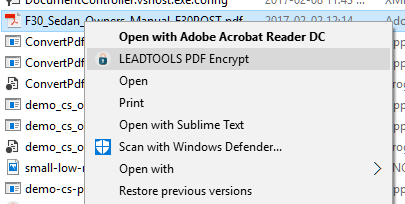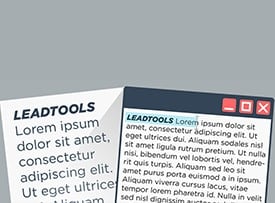
After reviewing the forums and responses to some surveys we recently send out, I noticed that many developers are looking for the best way to convert an image to a black & white PDF file. LEADTOOLS offers at least two solutions:
Posted on 2019-12-19 12:34:02 by Nick Villalobos

After reviewing the forums and responses to some surveys we recently send out, I noticed that many developers are looking for the best way to convert an image to a black & white PDF file. LEADTOOLS offers at least two solutions:
Categories:
Document Imaging
Posted on 2019-12-19 12:27:07 by Nick Villalobos
I recently became intrigued by some art work I saw online. It is a bunch of Rubik's cubes set up to reproduce a picture.
The artists are essentially reducing the image's colors down to a palette of six colors with dithering. By dithering the picture, it appears to look like the subject from a distance because the colors mix and merge to resemble the original colors. But the closer you get to the piece, the more it appears to be a bunch of randomly ordered colored squares. It sparked the artist in me, so I decided to use LEADTOOLS to help me come up with my own Rubik's Cubism-like art.
Posted on 2019-12-19 12:21:53 by Nick Villalobos

Continuing my adventure of "Going Paperless", I needed an easy way to encrypt PDF files before I added them to Evernote. To do this, I used the LEADTOOLS PDFFile() class to add a user password to a file. I created a console application with code to register itself into the Windows Explorer shell. Now I can right click any PDF file and encrypt it with a password. The LEADTOOLS code to do this is very easy; it took me longer to figure out how to edit the registry to add the application to the Windows Explorer context menu then it did to use LEADTOOLS to add the password.
One call got it done:
new PDFFile( fileName, password ) {
SecurityOptions = new PDFSecurityOptions {
UserPassword = newPassword,
EncryptionMode = PDFEncryptionMode.RC128Bit
},
CompatibilityLevel = PDFCompatibilityLevel.PDF15
}.Convert( 1, -1, null );Categories:
Document Imaging
Posted on 2019-12-19 12:19:20 by Nick Villalobos
 Low-resolution images can come from a variety of sources, but the most common source is probably screen capture. Screen capture images are usually 96 DPI on Windows. (This can vary depending on the user settings). Additionally, image representations of incoming faxes may also be considered low-res and fall under the resolution threshold acceptable for OCR. Typically, OCR engines require images of 200 or 300 DPI in order to achieve acceptable results.
Low-resolution images can come from a variety of sources, but the most common source is probably screen capture. Screen capture images are usually 96 DPI on Windows. (This can vary depending on the user settings). Additionally, image representations of incoming faxes may also be considered low-res and fall under the resolution threshold acceptable for OCR. Typically, OCR engines require images of 200 or 300 DPI in order to achieve acceptable results.
One easy solution for images that do not have noise or have complex structures is to change the resolution of the image before OCRing the image. This C# sample shows you how, then it gets the text from the image and outputs it to the console.
Posted on 2019-12-19 11:45:39 by Nick Villalobos

Even today there are many organizations that rely on fax as a required form of communications. Because of this, receiving faxes is a requirement that much still be met. To do this, many organizations utilize fax services either hosted locally or by a third-party. Many of these services will email received faxes to users as a PDF file.
In a normal facsimile transmission, every other scan-line is skipped. This reduces the amount of data that needs to be sent over the relatively slow connection used to send faxes. To account for the missing scan-lines, the aspect ratio of the pixels is 2:1. It is important to recognize this when displaying the image else you will end up displaying the image incorrectly, making it looked squashed.
Categories:
Recent Posts
Categories
Tags